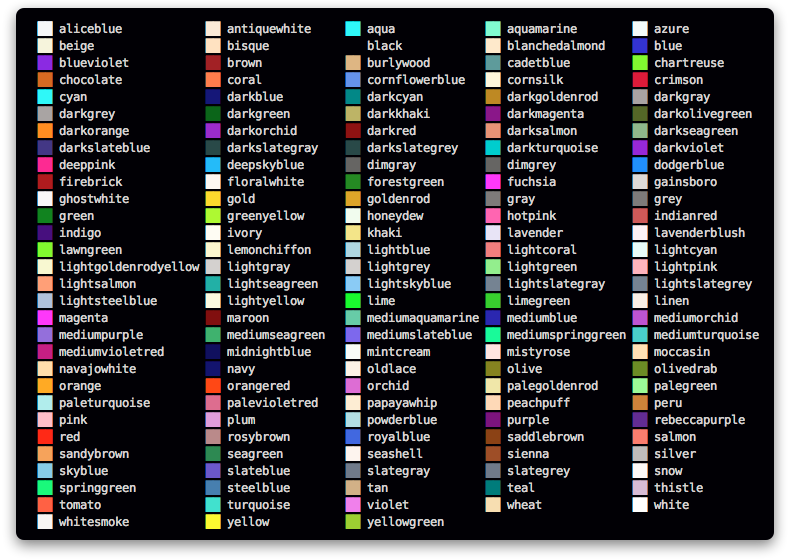trucolor-cli
v1.0.2
Published
TTY color toolkit supporting Truecolor (24bit RGB)
Downloads
2
Maintainers
Readme
![]()
trucolor-cli
A CLI Wrapper for trucolor
Publishing Status
Development Status
Documentation/Help
Usage
Installation
npm install --global @thebespokepixel/trucolor-cliSynopsis:
trucolor [options] "color description"...
Options:
-h, --help Display this help.
-v, --version Return the current version on stdout. -vv Return name & version.
-V, --verbose Be verbose. -VV Be loquacious.
-m, --message Format message with SGR codes
-i, --in Output SGR color escape code.
-o, --out Output cancelling SGR color escape code.
-t, --type CLI styling flags output.
-r, --rgb Output color as rgb(r, g, b).
-s, --swatch Output an isolated color swatch.
--color Force color depth --color=256|16m. Disable with --no-color![]()
In it's simplest form, trucolor 'color', will take any of the color expressions listed below and transform it into a simple hexadecimal triplet string, i.e AA00BB, ideal for passing into fish-shell's set_color built-in, or providing the basis of further color processing.
It can return color values and set terminal colors for a wide range of color assignment declarations and manipulation functions. See the examples below.
When outputting SGR codes, colors will be shifted to the availalble 256 or ansi color palette if 24 bit color is unavailable or will be omitted in a monochromatic terminal to make usage across environments safe. The CLI command respects --color=16m, --color=256, --color and --no-color flags. It does not affect value based output, such as the default or --rgb output, it only effects the --in, --out, --message and --swatch outputs.
The motivation for this is to allow more sophisticated graphic visualisation using in modern, xterm-compatible terminal emulators that have added 24 bit support.
Color definition
The color can be defined in any of the following formats:
CSS Hexadecimal
[#]RRGGBBor[#]RGBwhereR,GandBare 0-F.RGB
rgb:R,G,Borrgb(R,G,B)whereR,GandBare 0-255.
Spaces can be incuded in rgb(R, G, B) declarations but require quoting/escaping on the CLI.HSL (Hue Saturation Lightness)
hsl:H,S,LwhereHis 0-360,S0-100 andL0-100HSV (Hue Saturation Value)
hsv:H,S,VwhereHis 0-360,S0-100 andV0-100HSB (Hue Saturation Brightness) (just an alias for HSV)
hsb:H,S,BwhereHis 0-360,S0-100 andB0-100HWB (Hue White Black)
hwb:H,W,BwhereHis 0-360,W0-100 andB0-100
See HWB notation @csswgCSS named colors

Special formatters The following keywords modify the meaning or destination of the color, or provide enhanced foramtting. They only work when used with the command switches that actually output SGR codes, namely:
--message,--swatch,--inand--out. When used with the default command or with the--rgbswitch, they have no effect and the value of the base color (plus any processing) will be output.background: Set the background color, rather than the foreground.
normal: Set the color to the default foreground and background.
reset: Sets colors and special formatting back to the default.bold: Set the font to bold.
italic: Set the font to italic.
underline: Set underline.
dim: Set the colour to 50% opacity.
invert: Invert the foreground and background.
blink: Annoying as a note in Comic Sans, attached to a dancing, purple dinosaur with a talking paperclip.All of the above formatters need the correct code to end the range, either provided by using the
--outswitch, using theresetkeyword, or simply use the--messageoption to automatically set the end range SGR code. Usingnormalalone won't fully clear the formatting.
![]()
Color manipulation
A number of color operations can be specified, either before or after the base color declaration.
light: lighten by 20%
dark: darken by 20%
lighten percent: lighten by percent
darken percent: darken by percent
mono: make monochrome
saturate or sat percent: saturate by percent
desaturate or des percent: desaturate by percent
spin degrees: spin hue by by degrees
color mix color: mix colors
Multiple Inputs
trucolor will output a list of color values if more than one base color is specified, allowing color assignment in a single block allowing easy ingest using read. Each color will be output on it's own line, and named according to the input base color. The names can be overridden by providing a name: before the base color.
> trucolor red yellow green purple
red: ff0000
yellow: ffff00
green: 008000
purple: 800080
> trucolor Po: red LaaLaa: yellow Dipsy: green TinkyWinky: purple
Po: ff0000
LaaLaa: ffff00
Dipsy: 008000
TinkyWinky: 800080
> trucolor hsl:120,100,50 apples: orange spin 180
hsl-120-100-50: 00ff00
apples: 005aff


